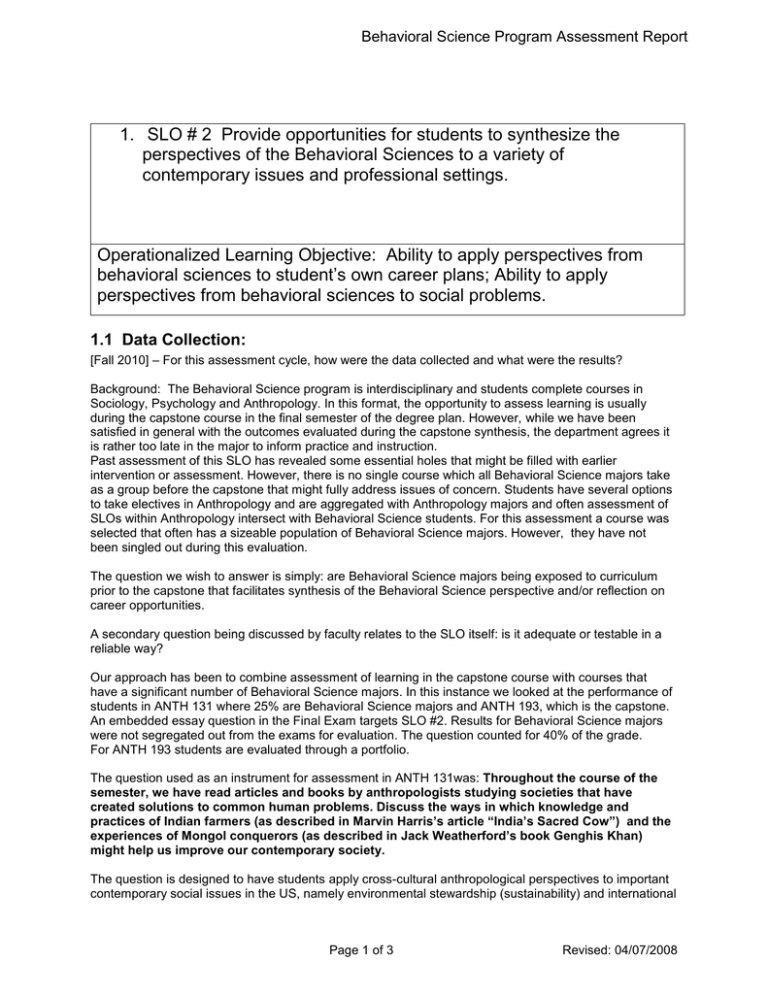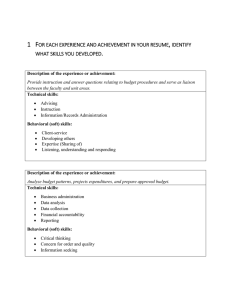Document 18011811
advertisement

Behavioral Science Program Assessment Report 1. SLO # 2 Provide opportunities for students to synthesize the perspectives of the Behavioral Sciences to a variety of contemporary issues and professional settings. Operationalized Learning Objective: Ability to apply perspectives from behavioral sciences to student’s own career plans; Ability to apply perspectives from behavioral sciences to social problems. 1.1 Data Collection: [Fall 2010] – For this assessment cycle, how were the data collected and what were the results? Background: The Behavioral Science program is interdisciplinary and students complete courses in Sociology, Psychology and Anthropology. In this format, the opportunity to assess learning is usually during the capstone course in the final semester of the degree plan. However, while we have been satisfied in general with the outcomes evaluated during the capstone synthesis, the department agrees it is rather too late in the major to inform practice and instruction. Past assessment of this SLO has revealed some essential holes that might be filled with earlier intervention or assessment. However, there is no single course which all Behavioral Science majors take as a group before the capstone that might fully address issues of concern. Students have several options to take electives in Anthropology and are aggregated with Anthropology majors and often assessment of SLOs within Anthropology intersect with Behavioral Science students. For this assessment a course was selected that often has a sizeable population of Behavioral Science majors. However, they have not been singled out during this evaluation. The question we wish to answer is simply: are Behavioral Science majors being exposed to curriculum prior to the capstone that facilitates synthesis of the Behavioral Science perspective and/or reflection on career opportunities. A secondary question being discussed by faculty relates to the SLO itself: is it adequate or testable in a reliable way? Our approach has been to combine assessment of learning in the capstone course with courses that have a significant number of Behavioral Science majors. In this instance we looked at the performance of students in ANTH 131 where 25% are Behavioral Science majors and ANTH 193, which is the capstone. An embedded essay question in the Final Exam targets SLO #2. Results for Behavioral Science majors were not segregated out from the exams for evaluation. The question counted for 40% of the grade. For ANTH 193 students are evaluated through a portfolio. The question used as an instrument for assessment in ANTH 131was: Throughout the course of the semester, we have read articles and books by anthropologists studying societies that have created solutions to common human problems. Discuss the ways in which knowledge and practices of Indian farmers (as described in Marvin Harris’s article “India’s Sacred Cow”) and the experiences of Mongol conquerors (as described in Jack Weatherford’s book Genghis Khan) might help us improve our contemporary society. The question is designed to have students apply cross-cultural anthropological perspectives to important contemporary social issues in the US, namely environmental stewardship (sustainability) and international Page 1 of 3 Revised: 04/07/2008 Behavioral Science Program Assessment Report diplomacy/ foreign relations, receptively. At the time of this writing we are in the process of distinguishing the results of assessment for this exam question by major. Evaluation of the results will be provided later as an adendum. We also used data collected from ANTH 193 portfolios which are graded holistically for evidence of understanding in this critical arena. The assessment mechanism in this course is qualitatively different and uses student presentations in addition to their portfolios. 1. All the students studying Harvard's LISA study of educational adjustments of immigrant youth in middle and high schools in the San Francisco Bay area and Boston. They broke into teams and researched a specific problem area such as providing appropriate counseling to immigrant students and their families, immigrant parental and family involvement in education, the articulation of public policy and the services provided to immigrant youth and how various factors, ranging from school safety to racism, effect the performance of immigrant youth. The students had two activities which the instructor could assess. First, the teams had to give a half hour presentation in which they analyzed the application of behavioral science research methodologies to the topic at hand. The students also had to suggest ways in which that research approach, and the findings that emerged, could be applied to local educational problems experienced by immigrant families. Second, they had to write a 2-3 page essay describing the application of behavioral science approaches to a social issue. That essay should touch on the LISA project, but most of it should relate to the plans of an individual student to apply behavioral science. For example, a student wrote about the way behavioral science research and findings could improve the efficacy of counseling to at-risk youth, and she also wrote about how similar strategies of information collection and analysis would benefit post-graduation work with autistic children. Out of 10 team presentations done in Fall 2010 and Spring 2011, all the groups were able to identify the application of behavioral science techniques to the plights of immigrant youth and draw some connection to similar applications to local issues. Out of a 25 papers (out of 50 total for both semesters), all but 2 were able to document how they would, or have already, applied behavioral science approaches to contemporary problems ranging from effective multicultural counseling to managing a diverse workforce. Two students were not able to go beyond their classroom experiences and imagine or remember how behavioral science knowledge could be applied. 2. The second assessment tool used was an assignment in which they had to apply to a specific graduate program, outlining potential research on a social issue, or a particular job within the social sciences, all of which involved applying behavioral science knowledge to a social issues, such as crime, at-risk youth, or mitigating a multicultural environment. This task was operationalized as an exercise in resume/cv writing along with an appropriately developed cover letter. In the first draft, extensive feedback was given. The overwhelming issue in the first draft was the inability for students to recognize experiences, skills and knowledge gained in the behavioral sciences as a practical asset. We engaged in exercises in which students went over their own transcripts and brainstormed specific projects and knowledge that they had accumulated in the behavioral sciences. In the second draft, which was turned in with the final portfolio. Out of a sample of 25 papers, all showed some improvement in their ability to document a concrete application of behavioral science knowledge to the social issue they intended to study (in graduate school) or ameliorate (in a social services job). Often the application was not spelled out in detail, but could be cogently outlined in the revised cover letter. 1.2 What have you learned about this Student Learning Outcome? [Fall 2010] – Based on the results in part I., briefly summarize the discussion surrounding this outcome, i.e., what does the faculty conclude about student learning for this SLO? As we learned in a previous assessment, students are not weak in overall performance, but in particular areas. They know the core subject areas and key findings of the parent disciplines, but do not necessarily understand how the knowledge in each field or discipline converge. This is not necessarily a Page 2 of 3 Revised: 04/07/2008 Behavioral Science Program Assessment Report product of either instruction or course curriculum, but student interest, involvement, and emphasis. But this is what we want to find out. In ANTH 131 the instructor judged the class as a whole answered the question in a manner strongly supporting an assessment that students were able to synthesize the perspectives of Behavioral Science, but not to a sophisticated degree. Since Anthropology Majors and Behavioral Science majors were not separated in the sample we can not say whether one group responded better than the other, but in general terms all students were measurably able to demonstrate the skills for which this SLO was intended. The overall assessment breakdown, however, reveals a significant range in the ability to synthesize the complexity of the test question. While 60% were able to answer the question at a level of 8 to 10 out of a possible 10, the others rated much lower nor did they relate to outside experiences. 1.3 Action Item(s) (if necessary): [Fall 2010] – Based on the discussion in part II., what actions will the department take to improve student learning, e.g., program changes, changes in pedagogy, process changes, resources requests, etc? The Behavioral Science program is being significantly redesigned. Two changes will take place that will improve student learning regarding application of behavioral science to social issues. First, the major was redesigned so that the 6 unit emphasis, which is currently defined by discipline (anthropology, sociology, psychology), will instead be reframed as a topic emphasis (childhood, multiculturalism, criminal behavioral, etc.) aligning the students learning much more closely with application to a specific social issue. Second, the capstone course will be a full 3-unit class, allowing ample time for exploring student learning related to several issues, not just the one covered in the book-length case study. 1.4 Results of Action Items [SEMESTER/YEAR] – What does assessment of student learning show after implementation of any action items? What, if anything, is planned next? We will be monitoring the Behavioral Science program changes in both the capstone course and courses where a significant number of Behavior Science majors are anticipated. Past experience suggests many if not most take the same four Anthropology courses to fulfill the Anthropology component of the major. While they have not been tracked in the past, we imagine some form of data collection allowing the department to better understand which classes Behavior Science students are taking. Such information will better inform faculty with regard to the SLOs for the program they should be emphasizing. This conversation will be an important feature in the end of year department meeting as well as the department one –day retreat at the start of the next academic year. Page 3 of 3 Revised: 04/07/2008


